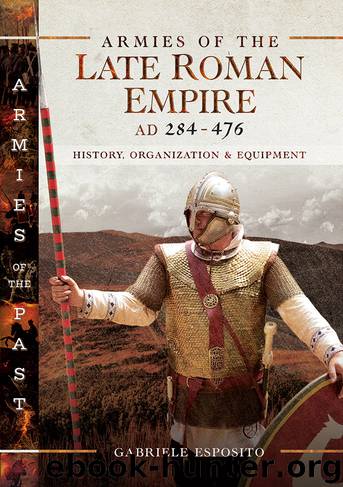Armies of the Late Roman Empire AD 284 to 476 by Gabriele Esposito

Author:Gabriele Esposito
Language: eng
Format: epub
Tags: HISTORY / Military / Ancient
ISBN: 9781526730381
Publisher: Pen & Sword Books
Published: 2018-10-29T16:00:00+00:00
Late Roman cavalryman, with lorica hamata and Spangenhelm.(Photo and copyright by Cohors Prima Gallica)
In battle, the screen of light infantry and light cavalry would loose their missiles on the enemy before the decisive engagement of the infantry lines. After performing this purely skirmishing function, they would retreat to the rear of their heavy infantry line (where, together with the foot archers and slingers already deployed there, they would continue to rain missiles on the enemy infantry). The heavy cavalry contingents forming the wings were to scatter the enemy cavalry facing them and then (if possible) encircle the main body of the enemy infantry. These tactical moves were not so different from those used by Caesar; the differences mostly regarded the heavy infantry. The Roman legionaries now had a quite passive role during pitched battles: instead of moving against the enemy as they had during the Principate, they preferred to wait the attack of the enemy infantry by keeping their defensive positions and forming a wall of shields.20 Thanks to the new combination of oval shield with longer offensive weapons (lancea and spatha), the Roman heavy infantrymen tried to use their superior coordination and organization to repulse the enemy attacks with crippling losses. When this happened, the battle was won. If the enemy was able to break the line of Roman heavy infantry, the battle was lost. As is clear from this general description, missile weapons were now much more important than before. During the Principate, the pila of the legionaries had the same tactical role that was now performed by specific skirmishing lines of light infantry and cavalry. In addition, the foot archers deployed to the rear of the heavy infantry played an important role during all phases of the battle. This general preference for fighting from a certain distance can be again explained as a result of the main tactical need: reducing human and material losses of the comitatenses to a minimum. As the years went by, especially during the very last decades of the Western Empire, light troops became increasingly important. Mounted archers, in particular, started to be much more numerous than cavalrymen equipped with heavy armour. This process was a direct result of the devastating Hunnic invasions into the heart of Roman Europe that were led by Attila.
Download
This site does not store any files on its server. We only index and link to content provided by other sites. Please contact the content providers to delete copyright contents if any and email us, we'll remove relevant links or contents immediately.
Shoot Sexy by Ryan Armbrust(17659)
Portrait Mastery in Black & White: Learn the Signature Style of a Legendary Photographer by Tim Kelly(16955)
Adobe Camera Raw For Digital Photographers Only by Rob Sheppard(16906)
Photographically Speaking: A Deeper Look at Creating Stronger Images (Eva Spring's Library) by David duChemin(16623)
Bombshells: Glamour Girls of a Lifetime by Sullivan Steve(13977)
Art Nude Photography Explained: How to Photograph and Understand Great Art Nude Images by Simon Walden(12975)
Perfect Rhythm by Jae(5326)
Pillow Thoughts by Courtney Peppernell(4214)
The Book of Joy by Dalai Lama(3903)
Good by S. Walden(3489)
The Pixar Touch by David A. Price(3369)
A Dictionary of Sociology by Unknown(3031)
Fantastic Beasts: The Crimes of Grindelwald by J. K. Rowling(2995)
Humans of New York by Brandon Stanton(2835)
Stacked Decks by The Rotenberg Collection(2812)
Read This If You Want to Take Great Photographs by Carroll Henry(2664)
On Photography by Susan Sontag(2577)
Insomniac City by Bill Hayes(2500)
Photographic Guide to the Birds of Indonesia by Strange Morten;(2490)
